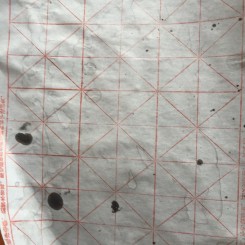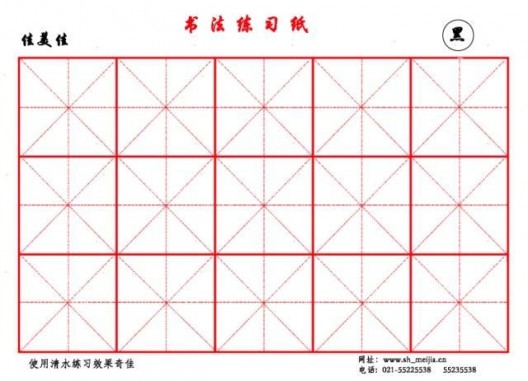Ding Yi’s paintings refuse to answer, to limit or be limited. Whether small or vast, their multi-hued fields of crosses map and divide pictorial space, transparent and unguarded, beguiling with pattern. But this is no panacea for interpretation, for anything-goes opinion. Look closely at each painting and you can become familiar with them, with the individual character of the multitude of marks that compose their seeming and actual similarity, the repetitions, threads and permutations, and yet still not know them. There is, specifically, no absolute answer. Each cross says this. This is not a matter of denial, as in the sense of being evasive, but refusal, in the sense of non-compliance. Identity is partly defined by others but also partly kept to the self. Inherent in each of Ding Yi’s paintings is an insistence on the inscrutability of the individual.
“I found it necessary to distance myself both from the burden of traditional Chinese culture and from the influence of early Western modernism in order to go back to the starting point of art, in order to literally start from zero.” —Ding Yi (1)
As a writer, I am neither mediating nor translating. Ding Yi does not need my interpretation, and nor do his paintings. Anyone can interpret them and that is intended and inherent in them. Ding Yi’s position is specifically against categorization and hierarchy, against positioning and against being positioned. Within the mass of humanity, its histories, philosophies and politics, whether judged from Ding Yi’s home of Shanghai or anywhere, the purpose of each painting is to be a statement and constant re-statement of individuality, his and frankly anyone’s, most importantly of the individual painting itself. As Greenberg might say, the painting is autonomous. Everything needed to interpret (not decode) is in the individual work. Nothing is hidden, even the overlapping layers are revealed.
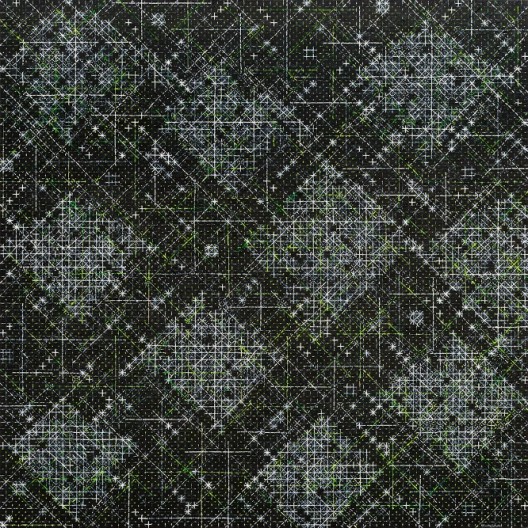
Ding Yi “Appearance of Crosses 2016-4″, 2016 (signed and dated on verso), mixed media on basswood, 240 x 240 cm (copyright Ding Yi; courtesy Timothy Taylor, London)
Yes / No / On / Off
Each of Ding Yi’s paintings and drawings comprise a mesh of small crosses of similar size, diagonal and perpendicular (+ x). Sometimes crosses have been painted in white on dark backgrounds, appearing to float on the surface. Other times, fluorescent paint is used, so in the darkness the crosses appear to hang in the air. Repeating, tracing, combining and boxing, Ding Yi attempts to explore every possible combination, every permutation of the glyph. It is a Borgesian endeavor.
One frame of reference is the practice of “Miaohong”, whereby children learn calligraphy by practicing writing with a brush characters on sheets of paper printed with grids divided perpendicularly and diagonally (see image 1). Sometimes characters are printed on the grid for students to trace. Sometimes the characters are written in water so that the paper can be reused many times. The model contains multiple possibilities which the user completes. It is both tool and medium, depending on who is the student, the user, the author, the painter, or reader.
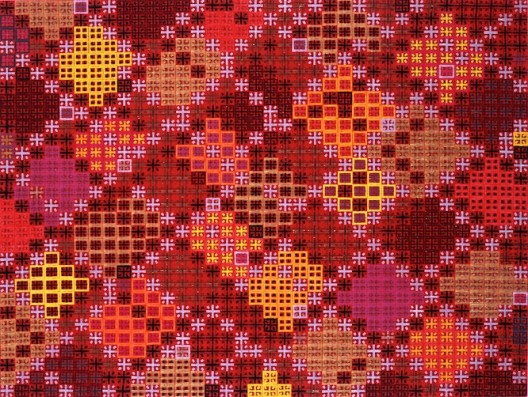
Ding Yi 丁乙 “Appearance of Crosses” 2010-6, Acrylic on tartan,120×160,2010, 示2010-6”丙烯、成品布 120x160cm 2010 (courtesy the artist and ShanghART)
There are many other (potential) frames of reference. Sometimes the crosses form perpendicular chains, perhaps suggesting the orientation of traditional script or the imagery of flowing data threads popularized in “The Matrix” series of films. A Christian might emphasize the appearance of crosses; a strategist, the game. Like the invented calligraphic language of Xu Bing, while the crosses and boxes are principally tied to a Chinese context, there are always paths into other traditions, or rather, possible paths. The grid contains the possibility for the entire Chinese language, past and future, all characters, correctly written and incorrectly, official and unofficial, lost or invented, traditional and simplified. (3)
And yet the crosses form neither a lexicon nor a key. The associations are picked up in encountering the picture, not random but also not dictated. Ding Yi’s paintings are not about vindicating answers but contemplating questions.
Positions against a position
x is a cross. It marks the spot. It is the point and the place. + is a cross. Each cross is a mark, and remark, and a re-mark. Each notes a position and states an (existential) position, its own subjective coordinates in relation to those around it. And then subsequent crosses reject and refuse the previous crosses. This is particularly apparent in certain recent paintings made on plywood foundation, which has allowed Ding Yi to also scratch in (or scratch-out) crosses. A history of statements and refusals builds up.
History is human. A house, a street, a city do not have stories but for the players who live and write them. Another way to see the crosses is as individual people, each person a character. Each one can be described, their subtle and myriad shades considered, poetically rendered even. Yet ultimately the individual, the complete being, remains not unreachable but undefinable. This is the essential allure of portraiture—not how it captures a likeness but how it fails to. Something always escapes. The individual is inevitably part of the system, the matrix, the mesh of society but also, finally, beyond categorization. Each repetition, each cross, states this. And simultaneously refuses to acknowledge it. Each cross is similar but also particular. Part of the individual remains beyond reach, whether refusing to be read—by refusing to decide.
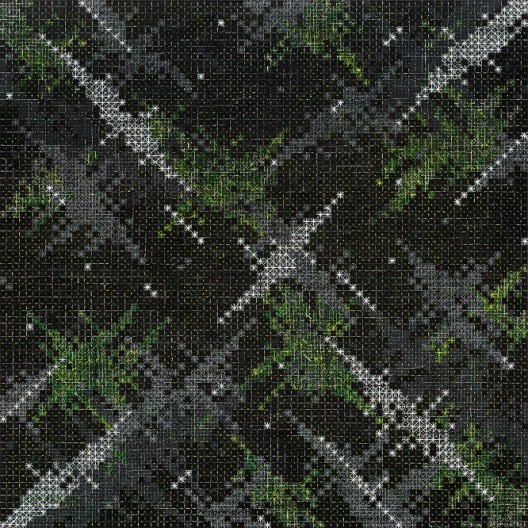
Ding Yi “Appearance of Crosses 2016-6″, 2016 (signed and dated on verso), mixed media on basswood, 240 x 240 cm (copyright Ding Yi; courtesy Timothy Taylor, London)
Abstract and abstraction
Palimpsests of pixels form clouds of hues, conjuring atmospheric works by other artists, whether Seurat or Monet. This fugitive familiarity, no doubt delusional, is part of the seductive charm of the paintings. Finding undefinable beauty in the otherness of color lends respite from the mundane. This beauty is a projection though. The crosses are merely crosses, but we see beauty in their masses. The craftwork, the handiwork, entailed in their creation, insist against mass production, against mechanization, even as Ding Yi appears to be copying it. In a sense, Ding Yi has made himself into a machine for making crosses, an anachronistic robot, a cipher for the cyborgs we have ourselves unbeknownst become. His precise and lonely work producing crosses in their multitudes disguises their individuality. Look closely and you can see the crosses. Draw back and they become shimmering masses of color, the process of painting tens of thousands of precisely formed crosses incurring inevitable errors, the DNA-evolutions resulting in fantastically cryptic plumage.
Each painting is meticulously composed over weeks and months. (Each work is literally pain+staking.) Some have light backgrounds, some dark. The pattern of marking is seemingly random but this is more a randomized effect, with Ding Yi’s eye always judging where to go next. It is the order of a sentient being exploring, going for a walk in a familiar terrain.
Some paintings have been made on unprimed canvas, others on wood bases. One semi-sardonic series was painted on traditional tartan cloth, including that of the Burberry fashion brand, though the traditional tribal semiotics and social functions of tartan cloth should also be noted. Some works are more colorful, some less. Some pulsate with fluorescent yellow, pink and green crosses. Sometimes there are fewer crosses, sometimes more, each glyph painted with precise strokes, usually but not always in one color. And even the crosses, as such, are figments of interpretation, with strokes used to compose crosses often not intersecting.
Recent works have witnessed a looser composition of individual crosses. lines comprising the crosses have become trailing, linking up and running off into other crosses. The black space they cross over remains unreachable, cut off by or from the grid floating above it. The web of lines form small windows (not keys) into the worlds of the older, bigger canvases, worlds created precisely not to be explicated. They are intended to remain abstract realities, foreign bodies. They represent themselves, even while another reality, the reality of their making, exists within Ding Yi himself.
Thibaut Verhoeven, writing on the meditative nature and slow composition of Ding Yi’s work, notes that, “It is the sort of slowness that sees no other possible result than a profound trance, a conscious turning away from reality via the endless, repetitive template-like action of painting.” (3)
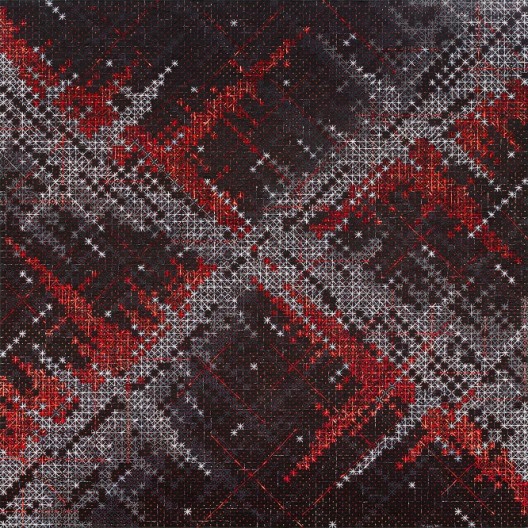
Ding Yi “Appearance of Crosses 2016-9″, 2016 (titled, signed and dated ‘”Appearance of Crosses 2016-9″ Ding Yi 2016′ on centre verso), mixed media on basswood, 240 x 240 cm (copyright Ding Yi; courtesy Timothy Taylor, London)
City
Eventually the mass of crosses builds up, and becomes a fabric, as if replicating in magnified form the very canvas on which it is painted (maybe this is partly the reason why Ding often leaves areas of the unprimed canvas visible). Another, equally valid view is to consider the network of repetitious marks as a map, of Shanghai in fact, where Ding Yi has lived his entire life.
Think of Mondrian’s “Broadway Boogie Woogie” (1943), completed soon after he moved to New York. It is almost commonplace to describe it as a map of New York but this assumes an aerial view. Maybe it is also a perpendicular map, a grid of highrises and the crevasses between them. And a map of the experience of moving through New York’s grid of streets and high rise buildings, night and day via cars, trains and elevators. Ding Yi’s works from 1988-1991 often are informed by Mondrian’s somewhat atypical but key work. Like New York, much of Shanghai is also built on a grid. The point here is not a simple association—otherwise Ding Yi could very easily add the word Shanghai to any work, but each painting is called simply “Appearance of Crosses” and dated. In a sense each cross is a person, someone in the city. They appear, they fade, come and go. There is order and chaos, multitudes and microcosms. Sometimes a mass of crosses of one colour washes over an area of painting like a storm. Another time they will define an area of light. Yet another, a specific geometrical space—a block, a building, or a sheet, a design…another painting. And so the randomized aesthetic takes hold, finding order in and through its development, emerging from tens of thousands of specific decisions, individual brush strokes, the meticulous method of painting eschewing the easy gesture, the emotional grandstanding of so much expressionist painting. The revelation appears in the refusal to explain. It is both ontological and existential.
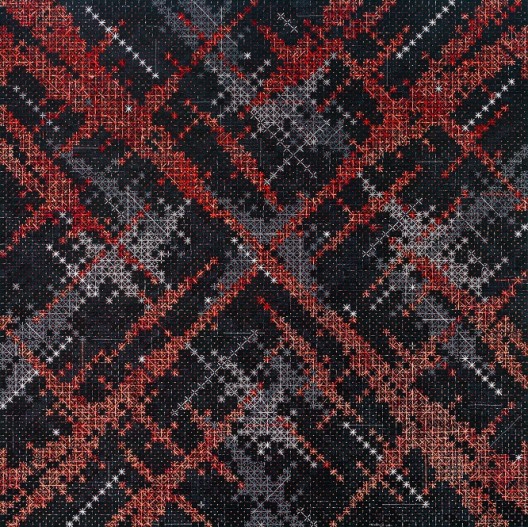
Ding Yi “Appearance of Crosses 2016-10″, 2016 (titled, signed and dated ‘”Appearance of Crosses 2016-10″ Ding Yi 2016.’ on centre verso), mixed media on basswood, 240 x 240 cm (copyright Ding Yi; courtesy Timothy Taylor, London)
Notes
1. Quoted in “Seeing, rather than perception. Ding Yi’s paintings in the context of European ways of looking at art”, Thibaut Verhoeven in Ding Yi. Specific. Abstracted., ex. cat., Minsheng Art Museum: Shanghai, 2012, p.15.
2. Traditional Chinese script is still used in Taiwan and Hong Kong, while the simplified script used today in Mainland China was a Maoist reform, successfully making the written language more accessible to the vast population, but also redacting a rich cultural tradition (highly conflicted issues of nationalism, history and identity dwell here). The boxes and their crosses are informed by all of this.
3. Verhoeven, op. cit., p.16.



